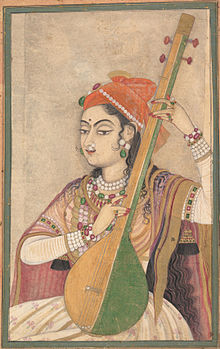Punjabi music
| Music of Pakistan | |
|---|---|
 |
|
| Genres | |
| Specific forms | |
| Religious music | |
| Traditional music | |
| Media and performance | |
| Music awards |
Lux Style Awards Hum Awards Pakistan Media Awards |
| Music festivals |
All Pakistan Music Conference Lahore Music Meet |
| Music media | |
| Nationalistic and patriotic songs | |
| National anthem | Qaumi Taranah |
| Regional music | |
| Local forms | |
| Related areas | |
| Music of India | |
|---|---|

A Lady Playing the Tanpura, ca. 1735 (Rajasthan)
|
|
| Genres | |
|
|
| Media and performance | |
| Music awards | |
| Music festivals | |
| Music media | |
| Nationalistic and patriotic songs | |
| National anthem | Jana Gana Mana |
| Regional music | |
|
|
Punjab is a region in South Asia, divided into two parts West Punjab (Pakistan) and East Punjab (India). Punjabi music has a diverse style of music, ranging from folk and Sufi to classical, notably the Patiala gharana.
Folk music of the Punjab is the traditional music of Punjab produced using the traditional musical instruments like Tumbi, Algoze, Dhadd, Sarangi, Chimta and more. There is a wide range of folk songs for every occasion from birth to death including marriage, festivals, fairs and religious ceremonies.
Folk music is often perceived as the traditional music of Punjab and typically has communal authorship. This aspect of folk music has shifted with time but the older categories of folk begin with the dhadi genre, which does follow ideas of communal authorship. The folk dhadi genre emphasizes stories of heroism and love stories, as exemplified by the numerous ballads of the legendary romantic tales of Hir-Ranjha and Sahiba-Mirza. Folk music is also commonly used in various life-cycle events in the Punjab region. “In almost every wedding ceremony family members, friends, and professional folk musicians perform different sets of folk songs which use themes from a nostalgic past, but communicate themes of separation, joy, fear, and hope in the present.” The lyrical content of many of these wedding songs have the paternal home depicted as a source of love and nurture, while the in-laws home is a source of tyranny and torture. Folk music continues to be used as a modern tool and a way of locating identification.
The notion of the traditional or folk music remains a critical part of Punjab society because it aids in the preservation of long-established customs. Life-cycle songs mostly “coincide with ritual occasions and they often mark stages in a ceremony” and can vary in topic ranging from birth to marriage. For example, family members and friends sing these songs during wedding festivities, by doing so help protect the traditional rituals associated with each step of the marriage. Suhag or ghorian, which are sung for the bride and groom respectively, typically give praise to God and ask for blessings from God. Women typically sing these songs in a choral fashion and may also focus on the ideal groom and bride. Both song genres celebrate the emotion of joy specifically surrounding the wedding process. The ghorian emotes feeling of “pure joy and desire”, while the suhag is a “mixture of joy and grief”. There are also songs that are associated with each night of the wedding starting as far back as five nights before to spread turmeric paste on the bride and groom. By having these songs, Punjabi people continue to celebrate the traditional cultural practices and have “transformed and even…revitalized” the way marriages are celebrated.
...
Wikipedia
